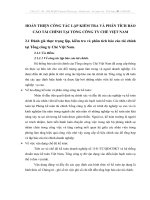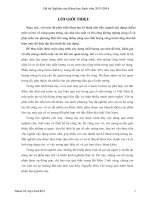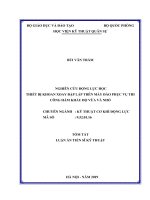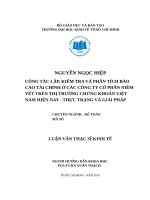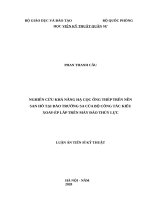Búa phá đá Caterpillar lắp trên máy đào - P7
Bạn đang xem bản rút gọn của tài liệu. Xem và tải ngay bản đầy đủ của tài liệu tại đây (216.59 KB, 13 trang )
Caterpillar Impact Products Ltd.
Caterpillar Hammers
What have I learned about Cat Hammers?
Test Time
Caterpillar Impact Products Ltd.
Caterpillar Hammers
Hammer Training Test
1. How does a hydraulic hammer break material?
a. By drilling into material.
b. By transfer of shock wave into material.
c. By hydraulic pressure and speed.
2. What is required from a hydraulic circuit to operate a hammer?
a. Flow at pressure.
b. Flow at temperature.
c. Relief pressure and nitrogen charge.
3. What is the goal for the hammer operating pressure?
a. Equal to system pressure relief.
b. Adjusted to nitrogen pressure.
c. Below relief valve’s crack point.
4. Tool wear limits prevent what from happening?
a. Tool seizing in bushing.
b. Misalignment with piston.
c. Improper contact with material.
1
Caterpillar Impact Products Ltd.
Caterpillar Hammers
Hammer Training Test
5. What is a Constant Blow Energy (CBE) system ?
a. The high frequency from distributor position.
b. Low pressure circuit access to inlet flow.
c . Regulation of power through the PAV spool.
6. A hammer stored for a year begins leaking after reinstalling
on carrier. What are the possible reasons?
a.
b.
7. Customer reports the hammer will not break material
after recent rebuild.. What are possible reasons?
a.
b.
c.
8. Pre-delivery inspection indicates low pressure circuit is below
specification. Explain what must be done?
2
Caterpillar Impact Products Ltd.
Caterpillar Hammers
Hammer Training Test
9. Will the hammer operate without nitrogen in the accumulator(s)?
If so, explain the symptoms would be seen?
10. Upon disassembly of accumulator, oil is found inside the
Nitrogen area. List the possible causes for the problem.
a.
b.
c.
11. What are the four key areas of a pre delivery inspection?
a.
b.
c.
d.
12. List the three most important operating techniques to
follow?
a.
b.
c.
3
Caterpillar Impact Products Ltd.
Caterpillar Hammers
Hammer Training Test - MASTER
1. How does a hydraulic hammer break material?
a. By drilling into material.
b. By transfer of shock wave.
c. By hydraulic pressure and speed.
2. What is required from a hydraulic circuit to operate a hammer?
a. Flow at pressure.
b. Flow at temperature.
c. Relief pressure and nitrogen charge.
3. What is the goal for the hammer operating pressure?
a. Equal to system pressure relief.
b. Adjusted to nitrogen pressure.
c. Below relief valve’s crack point.
4. Tool wear limits help prevent what...?
a. Tool seizing in bushing.
b. Misalignment with piston.
c. Improper contact with material.



